Neon Nostalgia: The Resurgence of 80s-Inspired Home Decor
Vibrant hues, geometric patterns, and a dash of retro glamour are making their way back into our homes. The 80s, once maligned for its excess, is now inspiring a new wave of interior design that blends nostalgia with modern sensibilities. This resurgence isn't just about neon signs and Miami Vice pastels; it's a reimagining of an era that celebrated boldness and individuality.

The Birth of 80s Aesthetics
The 1980s marked a departure from the earthy tones and natural materials of the 70s. As the world embraced new technologies and economic prosperity, interior design reflected this optimism and energy. Bold colors, unconventional shapes, and a mix of materials defined the era. Memphis Design, with its playful approach to form and color, became iconic of the period.
This design movement was a reaction to the minimalism of previous decades. It embraced asymmetry, bright colors, and graphic patterns. Furniture took on sculptural qualities, often featuring geometric shapes and laminate finishes. The overall effect was one of dynamism and visual interest, creating spaces that were anything but boring.
Modern Reinterpretation of 80s Design
Today’s 80s-inspired interiors are not carbon copies of the past. Instead, designers are cherry-picking elements that resonate with contemporary tastes. The key is balance - incorporating nostalgic touches without overwhelming the space. This might mean introducing a single statement piece, like a Memphis-style bookshelf, against a backdrop of neutral walls.
Color plays a crucial role in this revival. While the original 80s palette could be jarring, today’s approach is more nuanced. Designers are opting for softer versions of classic 80s hues, pairing them with muted tones for a more sophisticated look. For example, a pastel pink accent wall might be complemented by furniture in shades of gray and cream.
Texture and Materials: The Tactile Revolution
One of the hallmarks of 80s design was its embrace of diverse materials and textures. This aspect is being enthusiastically revived in modern interiors. Velvet, once considered outdated, is making a comeback on sofas and armchairs. Its plush texture adds depth and luxury to living spaces.
Terrazzo, a material that fell out of favor for decades, is experiencing a renaissance. Its speckled pattern is appearing not just on floors, but on countertops, wall coverings, and even as a print on textiles. This versatile material brings a playful element to any room, evoking memories of public buildings from the era while feeling thoroughly modern.
Lighting: From Functional to Fabulous
Lighting design in the 80s was all about making a statement, and this philosophy is being embraced once again. Neon signs, once relegated to dive bars and nightclubs, are finding their way into homes as art pieces. These glowing sculptures add a pop of color and a touch of whimsy to any room.
But it’s not all about neon. Designers are also revisiting other iconic 80s lighting styles. Arc floor lamps, with their dramatic curves, are perfect for creating a focal point in a living room. Frosted glass pendants in geometric shapes add a soft glow to dining areas. The key is to use these pieces as functional art, enhancing the overall aesthetic of the space.
Accessories: The Devil is in the Details
No 80s-inspired interior would be complete without the right accessories. This is where homeowners can really have fun with the trend without committing to major changes. Mirrors played a big role in 80s decor, and they’re back in a big way. Sunburst mirrors, a staple of the era, add a touch of glamour to any wall.
Art is another area where the 80s influence is strong. Abstract paintings featuring bold brushstrokes and vibrant colors are perfect for creating a focal point. For a more subtle nod to the era, consider framed movie posters from iconic 80s films.
The Future of 80s-Inspired Design
As with any trend, the key to longevity is adaptation. The current revival of 80s aesthetics is not about recreating the past, but about reimagining it for the present. Designers are finding ways to incorporate the best elements of the era - its energy, optimism, and creativity - into spaces that feel fresh and contemporary.
This trend also speaks to a larger movement in interior design towards personalization and self-expression. The 80s were all about individuality, and that spirit resonates with today’s homeowners who are looking to create spaces that reflect their personalities.
As we move forward, we can expect to see even more nuanced interpretations of 80s design. Perhaps we’ll see a fusion with other styles, creating entirely new aesthetics. Whatever form it takes, one thing is clear: the bold spirit of 80s design is here to stay, inspiring us to create homes that are vibrant, expressive, and utterly unique.





